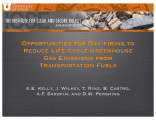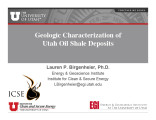TO
| Title | Date | Subject | Description | ||
|---|---|---|---|---|---|
| 151 |
 |
The effects of oxy-firing conditions on gas-phase mercury oxidation by chlorine and bromine: Topical report: April 2009 to June 2010 | 2010-10 | oxy-firing conditions; gas-phase mercury oxidation; bench-scale experiments; liquid-phase oxidation | Bench-scale experiments were conducted in a quartz-lined, natural gas-fired reactor with the combustion air replaced with a blend of 27 mole percent oxygen, with the balance carbon dioxide. Quench rates of 210 and 440 K/s were tested. In the absence of sulfur dioxide, the oxy-firing environment caus... |
| 152 |
 |
Subtask 3.2: Flameless oxy-gas process heaters for efficient CO2 capture | 2011-03-11 | Oxy-gas process heaters; efficient CO2 capture; oxy-gas combustion | This is a presentation given at the Unconventional Fuels from Oil Shale and Oil Sands Project Review Meeting in March 10-11, 2011. |
| 153 |
 |
Subtask 6.1: Engineering process models for economic impact analysis | 2011-03-10 | engineering process models; economic impact analysis; domestic heavy oil; developing domestic heavy oil/sands/shale resources | A presentation given at the Unconventional Fuels from Oil Shale and Oil Sands Project Review Meeting on March 10-11, 2011. In the project objectives, the purpose of assessment is to "Examine limiting factors to the development of domestic heavy oil, oil sands, and oil shale resources. Identify poli... |
| 154 |
 |
Subtask 4.3: Multiscale thermal processing of oil shale | 2011-03-10 | thermal processing; oil shale; oil shale treatment; thermal treatment | |
| 155 |
 |
Subtask 4.4: Effect of oil shale processing on water composition | 2011-03-10 | oil shale processing; water composition; unconventional fuels; oil shale; oil sands; oil shale development | A presentation at the Unconventional Fuels from Oil Shale and Oil Sands Project Review Meeting on March 10-11, 2011. The overall goal is to asses aquifers in the Uinta Basin to determine where saline water (produced along with conventional petroleum development) can be disposed without harming fresh... |
| 156 |
 |
Subtask 4.5: Pore scale analysis of oil shale/sands pyrolysis | 2011-03-10 | pore scale analysis; oil shale pyrolysis; oil sands pyrolysis; x-ray CT; pore network structure; flow simulation; LB method | A presentation given at the Unconventional Fuels from Oil Shale and Oil Sands Project Review Meeting on March 10-11, 2011. |
| 157 |
 |
Opportunities for oxy-firing to reduce life-cycle greenhouse gas emissions from transportation fuels | 2011-03-10 | GHG; oxy-firing; reduce greenhouse gas emissions; transportation fuel emissions; CO2 analysis; oil sands | The outline covers in this presentation covers: GHGs and the transportation fuel cycle. Motivation for reducing GHG emissions. Use of oxy-firing for CO2 capture in refining of conventional fuel. Use of oxy-firing for extraction and upgrading of oil sands. GHG emissions from other scenarios Would oxy... |
| 158 |
 |
Subtask 4.6: Kerogen/asphaltene/mineral matrix: Structure and interactions | 2011-03-10 | DOE review meeting; mineral matrix; recover organic material from oil shale/sands | A presentation given at the Unconventional Fuels from Oil Shale and Oil Sands Project Review Meeting on March 10-11, 2011. |
| 159 |
 |
Development of HPC-based simulations tool for in situ thermal processing of oil shale/sands | HPC-based simulations tool; in situ thermal processing; oil shale; oil sands; commercial production of oil shale; ecoshale in-capsule process | A presentation given at the Unconventional Fuels from Oil Shale and Oil Sands Project Review Meeting on March 10-11, 2011. | |
| 160 |
 |
DOE project review: Subtask 4.2 (B): Examination of in situ production models | 2011-03-11 | DOE project review; in situ production models; oil shale; unconventional fuels; oil sands; geomechanics; general reservoir simulation tool | A presentation given at the Unconventional Fuels from Oil Shale and Oil Sands Project Review Meeting on March 10-11, 2011. The objectives of the presentation is the examination of in-situ production methods, different in-situ production method options, rigorous energy and carbon balances, exploratio... |
| 161 |
 |
A market assessment of heavy oil, oil sands, and oil shale resources | 2011-03-10 | unconventional fuels; market assessment; developing domestic heavy oil, oil sands, and oil shale resources; preliminary infrastructure needs | A presentation given at the Unconventional Fuels from Oil Shale and Oil Sands Project Review Meeting on March 10-11, 2011. |
| 162 |
 |
Sedimentology of oil-impregnated, lacustrine and fluvial sandstone, P.R. Spring area, southeast Uinta Basin, Utah | 1970-08 | sedimentology; lacustrine and fluvial sandstone; P. R. Spring area; Oil-impregnated lacustrine and fluvial sandstone | Oil-impregnated intervals, up to 75 feet thick within a stratigraphic interval of about 250 feet in the Garden Gulch and Parachute Creek Members of the Green River Formation (Eocene), are exposed in beds that dip gently northward in the P. R. Spring area. Reserve estimates indicate that there may be... |
| 163 |
 |
Recovery of oil from Utah's tar sands | 1983-03-31 | Utah tar sands; bitumen cleaning; PRS-R tar sands; fluidized bed thermal recovery | This report covers the work accomplished at the University of Utah on Utah's tar sands during the period: October 1, 1979 to March 31, 1983. The work reported is a continuation of the program carried out over a period of years at the University. The primary effort of the work covered in this report ... |
| 164 |
 |
Recovery of bitumen from oil-impregnated sandstone deposits of Utah | 1975-11 | potential oil; bitumen; oil-impregnated sandstone (tar sand) deposits; tar sands; bitumen recovery | Utah contains at least 26 billion barrels of potential oil as bitumen in oil-impregnated sandstone (tar sand) deposits. As shown in this paper, these tar sands are significantly different in physical and chemical properties from commercially developed Canadian tar sands. These differences prevent di... |
| 165 |
 |
Recovery of oil from Utah's tar sands | 1979-11-30 | oil recovery; Utah tar sands; hot water recovery; thermal processing; synthetic fuel | This project is designed to develop necessary engineering data and technology for recovery of oil from Utah's tar sands. Progress reports for four major aspects of this project, namely Hot Water Recovery, Energy Recovery in Thermal Processing, Effect of Variables in Thermal Processing and Bitumen Pr... |
| 166 |
 |
Geologic characterization of Utah oil shale deposits | 2010-04-28 | oil shale development; geologic framework; lake evolution; oil shale; stratigraphic correlation | Why Geology? Economic prospectivity of oil shale development in the Uinta Basin relies heavily on establishing a solid geologic framework. Understanding lake evolution matters. |
| 167 |
 |
Quarterly Progress Report Phase 3: Clean and Secure Energy from Coal - October 1, 2011 to December 31, 2011 | 2012-02-16 | domestic coal resources; CO2 capture; Oxy-Coal | The University of Utah is pursuing research to utilize the vast energy stored in our domestic coal resources and to do so in a manner that will capture CO2 from combustion from stationary power generation. The research is organized around the theme of validation and uncertainty quantification throug... |
| 168 |
 |
Quarterly Progress Report Phase 3: Clean and Secure Energy from Coal - July 1, 2011 to September 30, 2011 | 2011-09 | domestic coal resources; CO2 capture; OFC | The University of Utah is pursuing research to utilize the vast energy stored in our domestic coal resources and to do so in a manner that will capture CO2 from combustion from stationary power generation. The research is organized around the theme of validation and uncertainty quantification throug... |
| 169 |
 |
Quarterly Progress Report Phase 3: Clean and Secure Energy from Coal - April 1, 2012 to June 30, 2012 | 2012-07-01 | domestic coal resources; CO2 capture; stationary power generation; oxyfuel combustor (OFC) | The University of Utah is pursuing research to utilize the vast energy stored in our domestic coal resources and to do so in a manner that will capture CO2 from combustion from stationary power generation. The research is organized around the theme of validation and uncertainty quantification throug... |
| 170 |
 |
Quarterly Progress Report Phase 3: Clean and Secure Energy from Coal - October 1, 2012 to December 31, 2012 | 2013-01-01 | domestic coal resources; CO2 capture; Oxy-Coal; Gasification | The University of Utah is pursuing research to utilize the vast energy stored in our domestic coal resources and to do so in a manner that will capture CO2 from combustion from stationary power generation. The research is organized around the theme of validation and uncertainty quantification throug... |
| 171 |
 |
Quarterly Progress Report Phase 3: Clean and Secure Energy from Coal - January 1, 2012 to March 30, 2012 | 2010-05-01 | domestic coal resources; CO2 capture; OFC simulation | The University of Utah is pursuing research to utilize the vast energy stored in our domestic coal resources and to do so in a manner that will capture CO2 from combustion from stationary power generation. The research is organized around the theme of validation and uncertainty quantification throug... |
| 172 |
 |
Phase II: Clean and Secure Energy from Coal: Quarterly Progress Report: January 1, 2011 to March 30, 2011 | 2011-05-01 | domestic coal resources; CO2 capture; coal; Oxycoal simulation team; coal sequestration | The University of Utah is pursuing research to utilize the vast energy stored in our domestic coal resources and to do so in a manner that will capture CO2 from combustion from stationary power generation. The research is organized around the theme of validation and uncertainty quantification throug... |
| 173 |
 |
Phase 2: Clean and secure energy from coal: Quarterly progress report: October 1, 2010 to December 31, 2010 | 2011-01-31 | domestic coal resources; CO2 capture; stationary power generation; LES; DQMOM approach; oxy-coal flames; coal | The University of Utah is pursuing research to utilize the vast energy stored in our domestic coal resources and to do so in a manner that will capture CO2 from combustion from stationary power generation. The research is organized around the theme of validation and uncertainty quantification throug... |
| 174 |
 |
Phase 2: Clean and secure energy from coal: Quarterly progress report: July 1, 2010 to September 30, 2010 | 2010-10-01 | domestic coal resources; CO2 capture; stationary power generation; Oxycoal; OFC; coal | The University of Utah is pursuing research to utilize the vast energy stored in our domestic coal resources and to do so in a manner that will capture CO2 from combustion from stationary power generation. The research is organized around the theme of validation and uncertainty quantification throug... |
| 175 |
 |
Phase 2: Clean and secure energy from coal: Quarterly progress report: April 1, 2010 to June 30, 2010 | 2010-08-01 | domestic coal resources; CO2 capture; stationary power generation; DQMOM approach | The University of Utah is pursuing research to utilize the vast energy stored in our domestic coal resources and to do so in a manner that will capture CO2 from combustion from stationary power generation. The research is organized around the theme of validation and uncertainty quantification throug... |
